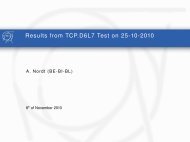A new 2 stage collimation design with new “L” shaped collimators.
A new 2 stage collimation design with new “L” shaped collimators.
A new 2 stage collimation design with new “L” shaped collimators.
Create successful ePaper yourself
Turn your PDF publications into a flip-book with our unique Google optimized e-Paper software.
Fermilab Tevatron Collimator<br />
FNAL-Tevatron<br />
Experience<br />
Dean Still<br />
April 14, 2005<br />
Fermilab – Tevatron Department<br />
Cern 2005
Tevatron Collimator Experience<br />
• Introduction:<br />
– Tevatron Machine Parameters<br />
– Overview Tevatron Collimator System<br />
• Halo Removal Performance<br />
• Protecting Against Abort Kicker Prefires<br />
• Collimators , Quenching and Damage<br />
FNAL-Tevatron<br />
Cern 2005
Tevatron Machine Parameters<br />
Injection Energy<br />
Flattop Energy<br />
Number of bunches<br />
Particles per bunch<br />
Total Beam Intensities at 150, 980<br />
Gev<br />
Orbits Types<br />
Lowbeta steps<br />
Beta *<br />
Number of IP’s<br />
Shot setup (Fill) time<br />
Store lengths<br />
FNAL-Tevatron<br />
150 Gev<br />
980 Gev<br />
36 proton & 36 antiproton<br />
220-260 E9 protons & 30-50 E9 pbars<br />
Protons 1E13 , 9E12<br />
Antiprotons 1.6 E12, 1.4E12<br />
Both beams in 1 vacuum pipe ; Beams<br />
separated by electrostatic separators<br />
15 different lattice in 25 steps<br />
1.7m and transition to 35cm<br />
2 : CDF & D0<br />
2 hours<br />
~ 30 hours<br />
Cern 2005
Tevatron Collimator Overview<br />
Motivation for Collimators for Collider II Run.<br />
• Collider I System was:<br />
– Slow motion controls.<br />
– not a 2 <strong>stage</strong> collimator system.<br />
– done completely manually and took 30 min<br />
• Collider II System desired:<br />
– A Halo Removal system only- To reduce losses at IP’s.<br />
– A <strong>new</strong> 2 <strong>stage</strong> <strong>collimation</strong> <strong>design</strong> <strong>with</strong> <strong>new</strong> <strong>“L”</strong> <strong>shaped</strong><br />
<strong>collimators</strong>.<br />
– An automated system that could be initiated by Collider<br />
Sequencer software.<br />
– Halo removal had be complete in 5 -10 min.<br />
FNAL-Tevatron<br />
Cern 2005
Tevatron Collimator for Halo Removal<br />
New System Build 4 <strong>new</strong> Targets and 12 <strong>new</strong> 1.5m Collimators<br />
for Halo Removal<br />
Amplitude<br />
yx ()<br />
1.5 1.5<br />
yminx ()<br />
ymaxx ()<br />
1<br />
0.5<br />
0<br />
0.5<br />
1<br />
Target<br />
@ ~5σ<br />
Collimator<br />
@~6σ<br />
FNAL-Tevatron<br />
2 Stage Collimator System<br />
Collimator<br />
Scattered<br />
trajectories<br />
−1.5<br />
1.5<br />
45 0 45 90 135 180 225 270 315 360 405<br />
−45 x<br />
Phase Adv. (degrees)<br />
405<br />
C0<br />
B0<br />
IR<br />
protons<br />
D0<br />
IR<br />
Proton Set 1<br />
D49 Tar, E03 & F172<br />
2nd<br />
Proton Set 2<br />
D171Tar, D173 & A0<br />
Pbar Set 1<br />
F49 Tar, F48 & D172<br />
Pbar Set 2<br />
F173 Tar, F171 & E02<br />
A0<br />
Cern 2005<br />
antiprotons<br />
target<br />
collimator<br />
E0<br />
F0
Tevatron Shot Setup Process<br />
Inject 36 final<br />
protons<br />
Open Helix &<br />
Inject 9 Trans<br />
of 4 Pbar bunches<br />
Accelerate<br />
Goto Lowbeta<br />
Remove Halo<br />
FNAL-Tevatron<br />
Cern 2005
Collimator Moving Order for Halo Removal<br />
Collimators move under 2 types of feedback:<br />
1) Loss monitor Feedback<br />
2) Beam intensity and Loss monitor feedback<br />
1 2 3<br />
4<br />
Move to Poised<br />
Position<br />
N*s<br />
FNAL-Tevatron<br />
p<br />
Fine Scrape Beam-Coll Pull back for<br />
Parallel<br />
Calibration<br />
Store<br />
p<br />
coll<br />
p<br />
Sequence in Time of Collimator movement for Halo Removal<br />
N*s<br />
p<br />
5<br />
Cern 2005<br />
Prepare for next<br />
sequence<br />
Time<br />
p
Proton & Pbar Targets moving during Halo Removal<br />
FNAL-Tevatron<br />
Proton bunched beam intensity<br />
Pbar bunched beam intensity<br />
F49 local BLM<br />
D49 local BLM<br />
BLM Stop Limit<br />
Remove .5% of proton beam<br />
Cern 2005
Collimator Controls Hardware<br />
Local Loss Monitors<br />
used for pbar losses<br />
F17<br />
Spool<br />
F171 F172<br />
Collimator Collimator<br />
FNAL-Tevatron<br />
F17<br />
Kicker<br />
Protons<br />
Local Loss Monitors<br />
used for proton losses<br />
F173<br />
Target<br />
F17<br />
Dipole<br />
VME based processor to conduct fast feedback<br />
Cern 2005
Collimator Controls Block Diagram<br />
C48<br />
Sequencer<br />
FNAL-Tevatron<br />
init<br />
abort<br />
set<br />
OAC is a Central Process<br />
that orchestrates global<br />
movement of all <strong>collimators</strong><br />
across 4 Front Ends<br />
BPM<br />
LATTICE<br />
FLYING WIRE<br />
read<br />
OAC<br />
calc xi(N,seq,ect)<br />
T:CCTLXX[NUM_COL]<br />
V:TEVCOL<br />
Coll FE(n)<br />
read/set<br />
seq map<br />
process<br />
read set V:TEVCOL<br />
coll status T:XXXenable - verify<br />
T: (mode) T:(mode) - go<br />
read state<br />
mdat<br />
tclk<br />
mcast<br />
Local Parameters[NUM_COLL]{<br />
xi [NUM_SEQ] sq<br />
xo[NUM_SEQ] NL<br />
dx[NUM_SEQ] PL<br />
dt[NUM_SEQ] Loss[NUM_SEQ]<br />
Mode[NUM_SEQ]<br />
enable[NUM_SEQ]<br />
Collimator<br />
Application<br />
read<br />
status<br />
map<br />
manual<br />
control<br />
graphics<br />
read/set<br />
coll<br />
local<br />
params<br />
Cern 2005
Tevatron Collimator Experience<br />
• Introduction:<br />
– Tevatron Machine Parameters<br />
– Overview Tevatron Collimator System<br />
• Halo Removal Performance<br />
• Protecting Against Abort Kicker Prefires<br />
• Collimators , Quenching and Damage<br />
FNAL-Tevatron<br />
Cern 2005
Halo Loss Reduction Facto<br />
100.00<br />
90.00<br />
80.00<br />
70.00<br />
60.00<br />
50.00<br />
40.00<br />
30.00<br />
20.00<br />
10.00<br />
0.00<br />
FNAL-Tevatron<br />
Halo Removal Efficiency<br />
Halo Removal Efficiency (Protons)<br />
1000 1500 2000 2500 3000 3500 4000<br />
7/2002 1/2005<br />
Store #<br />
CDF Protons D0 Protons<br />
1000.00<br />
900.00<br />
800.00<br />
700.00<br />
600.00<br />
500.00<br />
400.00<br />
300.00<br />
200.00<br />
100.00<br />
CDF Halo loss reduced ~ 10<br />
D0 Halo loss reduced ~ 1 until<br />
Vacuum and alignment improvements<br />
Halo Loss Reductio<br />
0.00<br />
Halo Removal Efficiency (Anitprotons)<br />
1000 1500 2000 2500 3000 3500 4000<br />
Store #<br />
CDF Anitprotons D0 Antiprotons<br />
CDF Halo loss reduced ~ 20<br />
D0 Halo loss reduced ~ 100<br />
Cern 2005
Halo Loss ( loss (hz)/intensity (1E9))<br />
10.00<br />
9.00<br />
8.00<br />
7.00<br />
6.00<br />
5.00<br />
4.00<br />
3.00<br />
2.00<br />
1.00<br />
0.00<br />
CDF & D0 Halo Loss vs. Store<br />
1000 1500 2000 2500 3000 3500 4000<br />
FNAL-Tevatron<br />
Store #<br />
CDF Protons CDF Anitprotons D0 Protons D0 Antiprotons<br />
Cern 2005
• Success<br />
Halo Removal Comments<br />
– New 2 <strong>stage</strong> <strong>design</strong> has proven to work <strong>with</strong><br />
good efficiency.<br />
– Automation process to Halo Removal very easy<br />
and reliable<br />
• Adapting<br />
– The Double scrape: Collimators stopping<br />
prematurely.<br />
– Alignment of Collimators; only checked 3 times<br />
a year<br />
FNAL-Tevatron<br />
Cern 2005
Halo Removal Comments- Continued<br />
• Problems<br />
– Quenching while scraping - Providing a Post-<br />
Mortem account in the Collimator Front end.<br />
– Quenching due to automating Halo Removal.<br />
Date<br />
March 2002<br />
March 2002<br />
March 2005<br />
March 2005<br />
March 2005<br />
FNAL-Tevatron<br />
Lost Store Comment<br />
Lost store at Halo removal due to mech stand failure<br />
Lost store at Halo removal due to mech stand failure<br />
Lost store at Halo removal due to D17 ahead of D49<br />
Lost store at Halo removal due to FE bug<br />
Lost store at Halo removal due to FE bug<br />
Cern 2005
Tevatron Collimator Experience<br />
• Introduction:<br />
– Tevatron Machine Parameters<br />
– Overview Tevatron Collimator System<br />
• Halo Removal Performance<br />
• Protecting Against Abort Kicker Prefires<br />
• Collimators , Quenching and Damage<br />
FNAL-Tevatron<br />
Cern 2005
History of Abort Kicker Prefires<br />
FNAL-Tevatron<br />
Prefire Collimators Not installed<br />
Collider Run I Prefires<br />
Cern 2005
Addition of A48 Collimator to Protect<br />
against A0 abort kicker prefires<br />
FNAL-Tevatron<br />
Add .5 m<br />
Collimator<br />
at A48 to shield<br />
against prefires<br />
C0<br />
B0<br />
A11V collimator<br />
Already in place<br />
IR<br />
protons<br />
D0<br />
IR<br />
A0<br />
Cern 2005<br />
antiprotons<br />
target<br />
collimator<br />
A0 proton abort<br />
kickers<br />
E0<br />
F0
A0 Kicker Transient Recorder<br />
P8 P10 P12<br />
P7 P9 P11<br />
AAK1 prefire kicks 6 bunches<br />
To To CDF.<br />
FNAL-Tevatron<br />
Antiproton Abort Kickers<br />
12 12<br />
7<br />
Bunches hitting<br />
the the A0 A0 abort block<br />
Proton Abort Kickers<br />
Cern 2005
A49 Loss Paddle for Prefire 3-8-2005<br />
CDF<br />
A49<br />
A49 Loss Paddle<br />
A48 Collimator<br />
A47<br />
Protons<br />
FNAL-Tevatron<br />
P7 P12<br />
AA marker<br />
A49 Loss Paddle<br />
A49 BPM Int.<br />
A47 BPM Int.<br />
Cern 2005<br />
P7-abort<br />
P8-Hit<br />
P9-Hit<br />
P10-Hit<br />
P11-Hit<br />
P12-Hit
A48U<br />
FNAL-Tevatron<br />
Quench Data<br />
Cell<br />
A48U<br />
F48U<br />
B15U<br />
A48L<br />
B15L<br />
F48L<br />
Line<br />
Cycle<br />
A48U is one of the fastest<br />
quenches we have had.<br />
0<br />
0<br />
2<br />
8<br />
9<br />
9<br />
Notice we did not quench A1<br />
Cern 2005
Comments on Kicker Prefire and Collimators<br />
• Tevatron did not originally <strong>design</strong> a collimator<br />
system to protect against kicker prefires.<br />
• Once the collimator was installed, it was hard to<br />
tell if the prefired beam was hitting it.<br />
• Once confident prefired beam hit the collimator,<br />
may need to increase length to protect<br />
downstream cold spool.<br />
• Need a better post-mortem system to determine<br />
where all kicked bunches went.<br />
FNAL-Tevatron<br />
Cern 2005
Tevatron Collimator Experience<br />
• Introduction:<br />
– Tevatron Machine Parameters<br />
– Overview Tevatron Collimator System<br />
• Halo Removal Performance<br />
• Protecting Against Abort Kicker Prefires<br />
• Collimators , Quenching and Damage<br />
FNAL-Tevatron<br />
Cern 2005
Collimators, Quenches and Damage<br />
• December 5, 2003<br />
– First learned of a <strong>new</strong> category of quench called a<br />
“Fast Quench”<br />
– A Roman Pot moved into beam due to a controls<br />
error causing beam loss damaging 2 <strong>collimators</strong> and<br />
2 spool pieces (3 correction elements)<br />
C18 spool E03 1.5m collimator D49 target<br />
FNAL-Tevatron<br />
Cern 2005
A48 Bus Drawing – Fast Quench<br />
Pot 3 location<br />
FNAL-Tevatron<br />
Protons<br />
A48U quenching dipoles: Looses current<br />
At .5A/msec before the abort fires<br />
Cern 2005
FNAL-Tevatron<br />
QPM Over Sample Buffer<br />
16msec<br />
Quench A48 1st Abort Fired<br />
Quenched 5 dipoles at A48; DI/Dt = .5A/msec<br />
Development of<br />
Quench:<br />
A48U 16msec<br />
D48L 13.5msec<br />
F17L 13msec<br />
E11U 12.5 msec<br />
Cern 2005<br />
Before abort<br />
(Courtesy D. Wolff<br />
& EE Support)
July 8,2004 – B11 Horizontal Separator Spark<br />
Quench Estimate of Orbit growth w/ QPM Fast Abort<br />
Fast<br />
Quench<br />
FNAL-Tevatron<br />
(mm)<br />
(mm)<br />
10<br />
10<br />
8<br />
8<br />
6<br />
6<br />
4<br />
4<br />
2<br />
2<br />
-4<br />
-4<br />
-6<br />
-6<br />
-10<br />
-10<br />
Hor orbit for F48 kick due to F4 Quench<br />
Hor orbit for F48 kick due to F4 Quench<br />
2 msec after quench<br />
2 msec after quench<br />
0<br />
0<br />
0 20 40 60 80 100 120<br />
-20<br />
20 40 60 80 100 120<br />
-2<br />
Resulting -8Orbit<br />
-8<br />
Due to fast quench<br />
Ring BPM location<br />
Ring BPM location<br />
Fast QPM abort would<br />
have stopped quenches in<br />
4 other houses<br />
Cern 2005<br />
Displacement @ # msec<br />
Displacement @ # msec<br />
real orbit<br />
real orbit<br />
diff sim-real<br />
diff sim-real
Minimum Level to<br />
Set BLM abort level<br />
BLM Plot from December 5 Quench<br />
FNAL-Tevatron<br />
Fast quench could have been detected<br />
Dipole at d4 could have pulled abort<br />
Abort Kicker fired<br />
Cern 2005<br />
1 frame=2msec
Tevatron Ring Wide Loss Plot (Dec 5)<br />
FNAL-Tevatron<br />
Cern 2005
FNAL-Tevatron<br />
Comments on Fast Quench<br />
• Tevatron masks all BLM inputs during a store<br />
due to very high probability of false abort.<br />
• Fixed the Fast Quench by QPM code; over<br />
sample and detect a large quench. Pulls abort<br />
<strong>with</strong>in 2msec instead of 16msec.<br />
• BLM upgrade is in the works to gain additional<br />
protection.<br />
• Host of mechanisms to create fast quench<br />
– Separator sparks<br />
– Motion controlled device, Vacuum values, pots,<br />
mirrors for sync light, <strong>collimators</strong><br />
Cern 2005
Comments on Fast Quench- Continued<br />
• May 15, 2004 – Unknown<br />
cause – Damaged E03<br />
collimator again<br />
• With a scan found it<br />
damaged and ran 3 months<br />
<strong>with</strong> it damaged.<br />
FNAL-Tevatron<br />
Cern 2005
FNAL-Tevatron<br />
Summary<br />
• Collider II Halo removal system has worked well as far as halo<br />
removal efficiency and automatic process.<br />
• Still working on improving collimator and post –mortem system for<br />
abort kicker prefires.<br />
• Dec 5,2003 quench and damage was “wake up call” to rethink<br />
Tevatron beam loss protection.<br />
• Learned details of <strong>new</strong> category of “fast quenches”.<br />
• Implemented <strong>new</strong> QPM code to abort on detection of quench <strong>with</strong>in<br />
1-2msec, instead of 16msec. But still mask BLM during stores due<br />
to false aborts.<br />
• Reviewed all motion controlled devices <strong>with</strong> appropriate Abort.<br />
– Vacuum abort upgrade done.<br />
– Pot motion upgrade done.<br />
• Insufficient process for gathering systematic and automatic data for<br />
analyzing past quenches involving beam loss. Working on better<br />
record keeping of data for every quench.<br />
• Provided input to <strong>new</strong> BLM system coming in 2005.<br />
Cern 2005



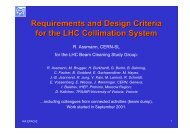
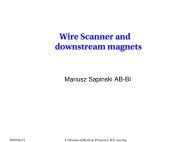
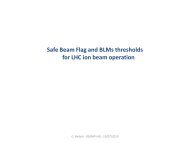
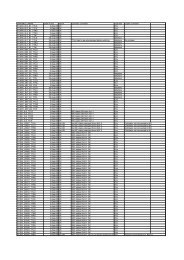
![marek.ppt [Read-Only] - LHC Collimation Working Group - Cern](https://img.yumpu.com/18209900/1/190x135/marekppt-read-only-lhc-collimation-working-group-cern.jpg?quality=85)
